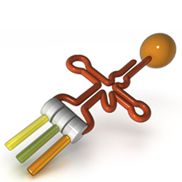
transfer RNA / tRNA
Transfer ribonucleic acid (tRNA) is a type of RNA molecule that helps decode a messenger RNA (mRNA) sequence into a protein. tRNAs function at specific sites in the ribosome during translation, which is a process that synthesizes a protein from an mRNA molecule. Proteins are built from smaller units called amino acids, which are specified by three-nucleotide mRNA sequences called codons. Each codon represents a particular amino acid, and each codon is recognized by a specific tRNA. The tRNA molecule has a distinctive folded structure with three hairpin loops that form the shape of a three-leafed clover. One of these hairpin loops contains a sequence called the anticodon, which can recognize and decode an mRNA codon. Each tRNA has its corresponding amino acid attached to its end. When a tRNA recognizes and binds to its corresponding codon in the ribosome, the tRNA transfers the appropriate amino acid to the end of the growing amino acid chain. Then the tRNAs and ribosome continue to decode the mRNA molecule until the entire sequence is translated into a protein.
Further Exploration
Concept Links for further exploration

















